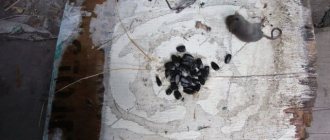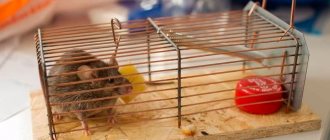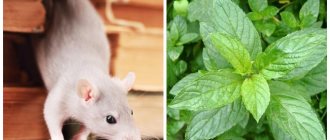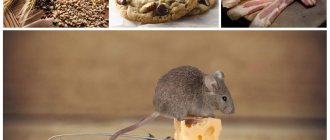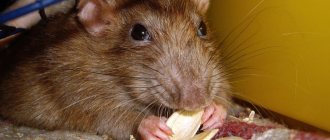It would seem that those who have their own house on the ground work in the summer and only rest in the winter. However, you should never let down your guard. From the beginning of cold weather, you need to make sure that mice do not get into the house and important outbuildings, do not spoil the insulation, do not get to food supplies, or chew through wires. Let's talk about how to protect ourselves from rodents or how to discourage their interest in our homes. After all, it is known that there are building materials that are more or less interesting for mice, which can be selected taking into account this problem; there are also effective ways to combat rodents.
What to consider during construction
The first rule for those who would not like to encounter rodents is maximum tightness. Mice enter through the cracks, after which they chew through the material and cause damage. This applies to laying insulation, sealing ventilation and other openings, and laying pipes.
The next, and perhaps the main question is the choice of material. First of all, we are talking about insulation. When choosing insulation, we are usually guided by cost considerations, but we do not take into account how much it will cost us to repair the insulation system after pests have taken over there. The entire layer of thermal insulation can become unusable in just a few months!
It’s important to figure out how realistic it is for a rodent to get into the room. If this is a house on a site where they do housework and where there are always a lot of mice, then you should immediately choose a material that is uninteresting for rodents. If mice are an unlikely occurrence, then you can choose any insulation, but take the issue of tightness seriously - prevent the presence of cracks in the ceiling, floor, near pipes, and also prevent rodents from entering the room through an open door or windows.
Ways to protect fruit trees
In winter, the wood of fruit trees is a real treat not only for mice, but also for hares and other rodents. The first thing you need to do if at least one side of your plot overlooks a forest or field is to fence off your own territory with a high, solid fence, installing it on a concrete base or digging it into the ground at least 30 cm.
Fruit tree wood is a treat for mice in winter
The following methods will help protect trees from mice in winter:
- When preparing a tree for winter, the trunk is wrapped in several layers of covering material, burlap, and nylon tights. Place branches of any coniferous tree between them, placing their needles down. The best option is spruce; its needles are short, prickly, and stick out in different directions. Cover the tree trunk circle with spruce branches. The needles prick the sensitive noses of rodents; they do not touch the tree. The spruce branches do not interfere with the aeration process.
- Wrap the trunk with roofing felt so that it is not completely adjacent to the tree. In winter, it will protect the tree not only from rodents, but also from sunburn. But the roofing material practically does not allow air to pass through, so the cover must be removed in time, avoiding the root collar becoming warm. Mice often make digs, so the roofing material needs to be dug into the ground at least 15–20 cm.
- Fence trees with fine mesh plastic or metal mesh. It also needs to be dug into the ground. Metal is simply too much for mice, and they really don’t like the specific taste of plastic.
- In preparation for winter, whitewash the trunk and the lower third of the skeletal branches. The composition based on slaked lime is quite caustic, mice do not like it. To enhance the effect, manufacturers add special substances that repel rodents to store-bought whitewash; to homemade whitewash, they add shavings of tar soap and zinc oxide (zinc compounds are the basis of many poisons for rodents).
- If you have old buckets and large pots without a bottom, put them on young seedlings, digging them 15–20 cm into the ground. Such a barrier is impenetrable for mice, but they sometimes climb over it from above.
The tree trunks of fruit trees are often mulched. In general, this is a very useful agrotechnical event. But do not choose straw as mulch - mice often live in it.
Video: how to protect a fruit tree from rodents
It is impossible to completely protect your own country house and garden from mice in winter. But it is quite possible to minimize the damage if you take care of the necessary prevention in advance. There are many ways to fight and repel mice - these include folk remedies, chemicals, and special devices.
If there are mice in the area
Let's consider the first case when there are mice on the site. What materials to choose for thermal insulation?
The first thing you should pay attention to is porous but solid materials and materials in a hard shell. The shell takes on the role of sealing and the porous filler, which mice might like, becomes simply inaccessible. A rat is capable of chewing through denser materials, but still will not be able to seriously damage the insulation, and repairing the damaged part will not be difficult.
comes first in this category .
The material is panels made of foamed silicate material, light in weight and easy to install. The material is uninteresting for rodents due to its high strength and composition, which has sharp edges when chipped. The pest won't go far.
Another option for those who have a risk of rodents entering the premises is foam concrete.
In addition to the fact that foam concrete is completely uninteresting for rodents, it has excellent soundproofing properties - this can be an argument when choosing more expensive insulation. It is as strong as foam glass, but slightly inferior in composition. And yet this material is almost not damaged by rodents.
There are two more options for insulation that rodents are highly unlikely to damage. Expanded clay is not interesting for the taste of mice, but they can move and make passages in it.
Expanded clay is granules made from baked clay and is used for thermal insulation in bulk. Affordable price and ease of use complement the advantages of this thermal insulation option. To prevent rodents from making tunnels in this material, it is enough to fix the granules with a liquid solution, which turns the heat-insulating layer into a monolith.
Among the materials that mice do not chew, there are not only hard and loose materials, but also soft insulation - ecowool. It contains an impregnation that repels any rodents.
Anyone who has rodents on their property and has a wooden house should remember these four insulation options. If mice are possible, but not with one hundred percent probability, you can consider other options.
Details
Formidable enemies
House mice are the largest population of mammals. They can reach a length of 9.5 cm and a weight of 0.03 kg. Due to the property of synanthropy - coexistence with humans - they are perfectly adapted to the lifestyle and human habitation. They are everywhere (the exception is Antarctica and the Far North). Little mice can run 5 km in search of the perfect home. She is especially active at the end of the summer season and in the fall, because she is afraid of the cold. Such rodents dig holes in the ground to a depth of 0.6 meters. Mice move along a constant path, leaving trails of droppings and dust, and holding it all together with urine. Its unusual smell can easily reveal the existence of a rodent indoors.
Mice live in families, where for each dominant male there are several females. The habitat (individual) around the nest will be from 900 to 1200 square meters. Mice try not to leave the area. House mice run fast, jump, climb well and even swim. They are capable of breeding all year round, and one female can produce up to 120 young per year. The constant proximity of man and mouse is an undeniable fact. But the fact that 80% of the entire genome of rodents coincides with humans is still a mystery. This feature is used in science to study diseases and treatment methods. The Methuselah Foundation works on the issue of aging, and in 2005 it awarded a prize to a laboratory mouse for its 5-year longevity record. A monument was erected to her in the Novosibirsk Academic Town.
The closest “colleagues” of house mice will be synanthropic black and gray rats. The lifestyle is similar to that of a mouse, but the damage done to the household is many times greater. Rodents will damage aluminum and lead pipes and live cables without harm to their health, creating an emergency situation in the transport and communication network. The peculiarity of the large rodent is the ability to adapt to poisons and can think abstractly. Due to this, the pest population is growing exponentially, despite active control - deratization.
What is the danger of rodents
If there are mice in a frame house, then not only the building structures, but also food supplies will suffer. Making their way into storage, animals can quickly destroy or even smear vegetables, cereals and fruits. They do not neglect anything, even candles, soap and adhesives, although they belong to a species of rodents, and their natural diet consists of plant seeds. Shoes, clothes, pieces of furniture, and books will become unsuitable for future use if they “meet” mice. Being around rodents is dangerous for people. Rats and mice carry severe, sometimes even fatal infections - plague, pseudotuberculosis, tularemia and leptospirosis. Infection occurs through contact with mouse feces or bites of blood-sucking arthropods that live on animals and easily pass to humans. All studies have confirmed that the virus that causes tumors in the mammary glands of mice is contagious to humans and can contribute to the development of mammary gland cancer.
Metal mesh is a real barrier for rodents
In order to encounter rats and mice on your own territory as little as possible, you need to make your home inaccessible from outside access. Protection of a frame house from rodents is carried out in a comprehensive manner - starting from building the foundation, and ending with the extermination of pests if they appear. To prevent mice from getting into the house, galvanized metal mesh is used, the mesh size of which is up to 0.6 cm. This size is due to the ability of the animal’s skull to flatten to a minimum volume. The plastic panel is unreliable, and rodents can easily deal with it. Expanded metal meshes are perfect for this. Even small rodents are not able to squeeze through the small hole. They are made from sheet metal with a thickness of 0.05 cm by cutting diamond-shaped cells and then stretching them. The product is abbreviated as TsPVS - all-metal expanded metal mesh.
The main application is the reinforcement of plasters and putties, but recently it has been widely used to protect frames from rats and mice. The material weighs very little, and does not spread when deformed. It is very durable, does not corrode and does not deteriorate from sharp mouse teeth. The mesh must be fastened directly to the frame with staples using a construction stapler or self-tapping screws with press washers. For installation on thermal insulation, special elongated clamps are used. The cost of the material is affordable, from 80 to 165 rubles per square meter. The investment will pay off with a restful sleep, saved money and nerves. In addition to TsPVS, woven meshes with cells up to 0.6 cm and a wire thickness of 0.12 cm are used. They are more expensive, up to 260 rubles per square, but the metal is more powerful and it can stop not only mice, but also rats. Rodents are able to go deep into the ground up to 0.6 meters. They enter the house through foundation cracks, floors and plinths, and therefore the main protection should be placed at the level of such structures. Professionals who have built dozens of frame houses recommend how to protect frame houses from rodents with mesh:
- Attach an underground vertical curtain along the common perimeter along the base and plinth to a depth of at least 1 meter.
- Lay a layer on the subfloors that precedes the insulation material so that mice cannot get into it and then settle in.
- Trim the outer corners of the building before finishing work begins.
- Close ventilation gaps, vents, base chimneys and other technological openings.
Possible entry points for rodents can be covered with a barrier that is impenetrable to them. The main requirements for the mesh are mesh size - up to 0.6 cm and normal thickness of the zinc layer. The mouse will fit into larger holes without problems, but poor galvanizing quality will cause the metal base to quickly collapse.
Materials that are sometimes damaged by rodents
Mineral wool - sometimes damaged by rodents, but positions itself as a material in which rodents do not live.
The fibers are rarely damaged, but mice can build nests in them. When using this material, it is important to lay the mineral wool so that it does not deform.
Extruded polystyrene foam is a fairly dense raw material, so rodents rarely penetrate it, and yet such cases do occur. Unfortunately, this material will not be a barrier for rats.
Polyurethane foam is a dense material that is rarely damaged by rodents. However, if constant protection is not provided, over time it becomes less dense, begins to deteriorate and can easily be chewed by pests.
To ensure that this moment does not come so quickly, you need to think about reliable protection of the foam from moisture and ultraviolet radiation. This can be achieved through coloring.
Glass wool practically keeps mice out, and even a thin layer is enough. This is achieved due to the traumatic composition. However, over time, its properties may become less dangerous for rodents.
How not to protect a frame house from rodents
In some sources you can find information that to protect a frame house from rodents it is enough:
- Get a cat.
- Spread the poison.
- Set up mousetraps.
Relying on these tips is highly discouraged. A cat will not help get rid of constantly arriving colonies of rodents. The same pets can eat the poison. And this is at best... As for mousetraps, they are extremely ineffective due to the number of offspring that rodents are famous for.
Materials that rodents especially love
Now a list of materials that rodents quite like.
Polystyrene foam is most often chosen as insulation and is most liked by rodents.
If there is even the slightest risk of mice getting into the house, the foam will be chewed through and even spread throughout the house.
Penoizol is foam plastic, only sprayed. Almost no different in popularity among rodents. Mice chew through it a little worse than polystyrene foam, but still quite often and abundantly.
Expanded polystyrene is a little denser, but the effect is almost the same.
Ways to deal with mice
If rodents have already appeared, or there is even the slightest suspicion, you need to act immediately. Fortunately, there are a lot of ways to fight.
Poisons
A good method of struggle, but it has at least 2 serious drawbacks.
Pets can be poisoned by the poison. Either from a dead rodent or from a poisoned product that was eaten by a cat.
Sellers assure the buyer that after eating the poison, the rodents will mummify in the shortest possible time. This means that the smell from their corpses will not spread throughout the house. As a result, it turns out that dead mice in hard-to-reach places still decompose, emitting such a stench that it is sometimes impossible to be in the house, let alone live there.
Therefore, before you fight mice with poisonous agents in a frame house, you need to carefully weigh everything. Use them under floors during the period when it is time for rodents to retire. This is the autumn period of the year.
Mechanical methods
The mice that appear can be hunted in the literal sense of the word, by setting traps or mousetraps. The method is effective when, after these devices are placed in the right places, at least the identified holes are sealed.
Biological methods
The enemy of mice is the cat. And no one will rid the house of their invasion as effectively as this affectionate four-legged friend. If mice appear in the house, and a cat lives here, then 100% protection for the building is provided. It will catch the individuals living in it constantly and very effectively, and quickly. Those he cannot catch will simply leave the house.
Ultrasound
This method is considered effective and one of the best, including for frames. The electronic device (repeller) has a built-in control system that guarantees continuous operation of the device. In addition, it specifically affects the rodent. The device emits ultrasonic radiation, which makes the mice uncomfortable to be around, and they are forced to vacate the territory they occupy.
To protect your home and surrounding area from mice infestation, one device will not be enough. You need to buy and install at least 4 repellers. This is the only correct method and the answer to the question, if mice appear in a frame house, then how to get rid of them when any other methods do not work.
Advice! It is better to place it on each corner of the house.
Traditional methods of protection
You can fight rodents using the proven methods of our ancestors.
Cork (wine) cork, cut into small pieces, mix with bait cereal, season with vegetable oil (preferably unrefined). Sprinkle in areas where mice frequent. If it gets into the digestive tract of a rodent, the cork will swell and, getting stuck in the intestines, will lead to its death.
Rodents have a terrible intolerance to naphthalene. You can mix sawdust with it and pour it into their loopholes and holes.
Mix ordinary lime (necessarily quicklime) with sugar and sprinkle it on the mice. Lime, entering the digestive tract (namely the stomach), will begin to react strongly with gastric juice. It gets very hot, thereby causing the death of the rodent.
Semolina can be mixed with gypsum, dry plaster, and scattered near the holes. Once eaten, the mixture will harden and the mouse will die.
Diesel fuel, formaldehyde and kerosene have always served as popular rodent repellers. If you use them to treat basements, outbuildings and all places where rodents live, they will run away from the pungent and poisonous smell. These compounds have a rather persistent smell, which means they will not return soon.
According to popular beliefs, wood ash, which contains alkali, can also help drive out rodents. Crushed ash, scattered under floors and in places where rodents are located, eats away at their paws. This means that they will lick it off, and then the second factor will come into force - the alkali will begin to irritate the gastric mucosa. Therefore, they will be forced to leave this house. Wood ash is completely safe for human health. And this method of protection can be considered universal.
Causes provocateurs leading to the appearance of rodents
Human habitation has always attracted rodents due to the presence of food. A frame house can serve as an ideal and easily accessible shelter for them, where entire colonies can spend the winter in warmth and abundance. They can penetrate here very easily, because it is difficult, when erecting a frame, to avoid the presence of cracks.
They can also penetrate the building through the finishing sheathing. If the insulation is incorrectly installed or chosen, voids often appear in it, through which rodents can move unhindered.
Advice! To prevent mice from choosing your home, choose those types of insulation that are not “interesting” to them.
A common reason that mice in a frame house have multiplied their colonies is the close localization of the structure to garbage beams or a landfill. Therefore, those who choose a place for building a frame structure must take this fact into account by locating their cottage as far as possible from them.
Causes of rodents
Various types of rodents, just like insects, can settle next to a person and cause him a whole lot of inconvenience.
It is often not so easy to remove them, since these pests try to avoid direct contact with people, adapt to virtually any living conditions, and also constantly learn not to fall into traps and recognize poisoned food.
Before you begin to destroy such unwanted neighbors, you must first find out the possible reasons for their appearance in order to avoid relapses in the future.
Most often, their appearance is accompanied by the following factors:
- The presence of food and various edible supplies that are stored in places that are accessible to mice. It is worth noting that storing food in bags and even hanging cabinets is not considered a sufficient degree of protection, since such obstacles are not insurmountable for rodents.
- Violation of sanitary standards in the premises, which can be expressed in rare garbage removal, leading to its accumulation in large volumes, as well as extremely rare cleaning. All these factors create a favorable environment for rodents to live in, since among the waste there is almost always food suitable for them.
- Favorable temperature conditions, this factor becomes most relevant with the onset of winter cold, when mice are ready to sacrifice their own safety for the sake of moving to warmer places, including human homes.
- Mass migration of rodents, which can begin due to the fact that someone nearby began to purposefully poison and exterminate them.
